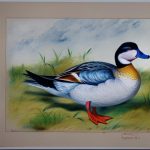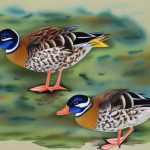Female duck breeds are an essential part of any duck farming operation. They are valued for their egg production, meat, and even as pets. There are many different breeds of female ducks, each with its own unique characteristics and qualities. Whether you are looking to start a small backyard flock or a large commercial operation, there is a female duck breed that will suit your needs. In this article, we will explore some of the most popular female duck breeds, their characteristics, egg production, care and maintenance, breeding and reproduction, and help you choose the right breed for your specific needs.
Key Takeaways
- Female duck breeds come in a variety of sizes, colors, and temperaments, making them a popular choice for backyard poultry enthusiasts.
- Some popular female duck breeds include the Pekin, Khaki Campbell, and Indian Runner, each with their own unique characteristics and egg-laying abilities.
- Female duck breeds are known for their hardiness, adaptability, and ability to forage for food, making them relatively low-maintenance compared to other poultry.
- Female ducks are prolific egg layers, with some breeds capable of laying up to 300 eggs per year, making them a valuable addition to any small farm or homestead.
- Proper care and maintenance of female duck breeds includes providing a suitable living environment, balanced nutrition, and regular health checks to ensure their well-being and productivity.
Popular Female Duck Breeds
1. Khaki Campbell: The Khaki Campbell is a popular breed known for its excellent egg-laying abilities. They are a medium-sized duck with a khaki-colored plumage. Khaki Campbells are known to lay up to 300 eggs per year, making them one of the most productive duck breeds. They are also known for their friendly and sociable nature, making them a great choice for backyard flocks.
2. Pekin: Pekin ducks are one of the most popular duck breeds in the United States. They are large, white ducks with a calm and friendly disposition. Pekins are known for their fast growth rate and excellent meat production. While they are not as prolific egg layers as some other breeds, they still produce a respectable number of eggs each year.
3. Runner: Runner ducks are a unique breed known for their upright posture and distinctive running gait. They come in a variety of colors and are valued for their excellent egg-laying abilities. Runner ducks are also known for their foraging skills and adaptability to different environments, making them a great choice for free-range operations.
Characteristics of Female Duck Breeds
Female duck breeds come in a wide range of sizes, colors, and temperaments. Some breeds are known for their excellent egg-laying abilities, while others are valued for their meat production or ornamental qualities. When choosing a female duck breed, it’s important to consider factors such as climate, available space, and intended use (egg production, meat, or pets). Additionally, some breeds may be better suited for free-range operations, while others may thrive in a more confined space.
In terms of temperament, some female duck breeds are known to be more docile and friendly, while others may be more independent and active. It’s important to consider the temperament of the breed when choosing ducks for your flock, especially if you have children or other animals on your property. Additionally, some breeds may be more vocal than others, so it’s important to consider noise levels if you have close neighbors.
Egg Production in Female Duck Breeds
Egg production is one of the main reasons why people choose to raise female duck breeds. Different breeds have varying levels of egg production, with some being highly prolific layers and others being more moderate in their output. Khaki Campbells, for example, are known for their exceptional egg-laying abilities, with some individuals laying up to 300 eggs per year. Pekin ducks, while not as prolific as Khaki Campbells, still produce a respectable number of eggs each year.
The quality of the eggs produced by different duck breeds can also vary. Some breeds may lay larger eggs with thicker shells, while others may produce smaller eggs with thinner shells. It’s important to consider the intended use of the eggs when choosing a duck breed. For example, if you plan to sell the eggs or use them for baking, you may want to choose a breed that produces larger eggs with strong shells.
In addition to egg production, some female duck breeds are also valued for their ability to go broody and hatch their own eggs. This can be a desirable trait for those looking to raise ducks without the need for an incubator. Runner ducks, for example, are known to be good mothers and will often go broody and hatch their own eggs.
Care and Maintenance of Female Duck Breeds
Proper care and maintenance are essential for keeping female duck breeds healthy and productive. Ducks require access to clean water for drinking and bathing, as well as a balanced diet that includes a mix of commercial feed and fresh greens. It’s important to provide ducks with adequate shelter from predators and the elements, as well as access to a safe and secure outdoor space for exercise and foraging.
Regular health checks are also important for maintaining the well-being of female duck breeds. This includes monitoring for signs of illness or injury, as well as providing routine vaccinations and parasite control. Additionally, ducks should have access to clean bedding and nesting areas to ensure optimal comfort and hygiene.
It’s also important to consider the social needs of female duck breeds. Ducks are social animals and thrive in the company of others. Providing ducks with companionship and opportunities for social interaction can help prevent boredom and reduce stress-related behaviors.
Breeding and Reproduction of Female Duck Breeds

Breeding and reproduction are important considerations for those looking to raise female duck breeds. Ducks reach sexual maturity at around 5-7 months of age, at which point they can begin laying eggs. It’s important to provide ducks with suitable nesting areas and materials to encourage natural egg-laying behavior.
For those looking to breed ducks, it’s important to consider factors such as genetic diversity, temperament, and intended use of the offspring. Selecting breeding stock with desirable traits such as good egg production, meat quality, or ornamental qualities can help improve the overall quality of the flock.
When it comes to hatching duck eggs, there are several options available. Ducks can be allowed to go broody and hatch their own eggs naturally, or eggs can be collected and placed in an incubator for artificial hatching. It’s important to provide proper care and nutrition to breeding ducks to ensure successful reproduction and healthy offspring.
Choosing the Right Female Duck Breed
Choosing the right female duck breed is an important decision that should be based on your specific needs and goals. Whether you are looking for prolific egg layers, excellent meat production, or friendly pets, there is a female duck breed that will suit your needs. Consider factors such as climate, available space, intended use (egg production, meat, or pets), temperament, and noise levels when choosing a duck breed for your flock.
It’s also important to consider the long-term care and maintenance requirements of different duck breeds, as well as their breeding and reproductive characteristics if you plan to raise ducks for future generations. By carefully considering these factors and doing thorough research on different duck breeds, you can choose the right female duck breed that will thrive in your specific farming or homesteading operation.
If you’re interested in learning more about female duck breeds, you might also want to check out this informative article on Poultry Wizard about converting a shed to a chicken coop. Understanding the different types of poultry housing can be beneficial for both ducks and chickens, as it provides insights into creating a suitable environment for your feathered friends. You can read the article here.
FAQs
What are some common female duck breeds?
Some common female duck breeds include the Pekin, Khaki Campbell, Indian Runner, and Rouen.
What are the characteristics of female duck breeds?
Female duck breeds typically have a more subdued coloration compared to male ducks. They also have a more rounded body shape and tend to be quieter than their male counterparts.
What are some popular uses for female duck breeds?
Female duck breeds are often raised for their eggs, meat, and pest control. They are also popular as pets and for ornamental purposes.
How do you care for female duck breeds?
Female duck breeds require access to water for swimming and bathing, a balanced diet of commercial duck feed and fresh greens, and protection from predators. They also need regular veterinary care and access to a safe and comfortable shelter.
What is the average lifespan of female duck breeds?
The average lifespan of female duck breeds is around 8-12 years, although this can vary depending on the breed and the level of care they receive.
Meet Walter, the feathered-friend fanatic of Florida! Nestled in the sunshine state, Walter struts through life with his feathered companions, clucking his way to happiness. With a coop that’s fancier than a five-star hotel, he’s the Don Juan of the chicken world. When he’s not teaching his hens to do the cha-cha, you’ll find him in a heated debate with his prized rooster, Sir Clucks-a-Lot. Walter’s poultry passion is no yolk; he’s the sunny-side-up guy you never knew you needed in your flock of friends!







